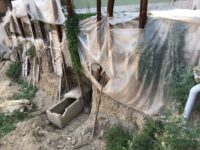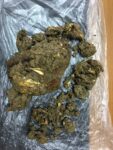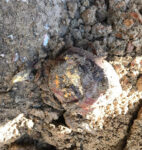 A Roman sarcophagus containing a gold diadem was discovered during construction in Izmir, Turkey. Workers came across the stone coffin when digging a foundation in the historical district of Konak and reported the find to the Ministry of Culture and Tourism. A rescue excavation unearthed the sarcophagus with lid containing human remains, fragments of ceramic and fragments of a gold diadem. The crown was removed for study and conservation while the sarcophagus was fully excavated in situ.
A Roman sarcophagus containing a gold diadem was discovered during construction in Izmir, Turkey. Workers came across the stone coffin when digging a foundation in the historical district of Konak and reported the find to the Ministry of Culture and Tourism. A rescue excavation unearthed the sarcophagus with lid containing human remains, fragments of ceramic and fragments of a gold diadem. The crown was removed for study and conservation while the sarcophagus was fully excavated in situ.
 It has not been radiocarbon dated yet, but archaeologists believe the sarcophagus and remains are from the 2nd century A.D., a period when ancient Smyrna was at its peak prosperity under the Roman Empire. The diadem is extremely rare and indicates the deceased was a member of the ruling class.
It has not been radiocarbon dated yet, but archaeologists believe the sarcophagus and remains are from the 2nd century A.D., a period when ancient Smyrna was at its peak prosperity under the Roman Empire. The diadem is extremely rare and indicates the deceased was a member of the ruling class.
The settlement on the Gulf of Izmir dates back to the Neolithic, making it one of the most ancient settlements of the Mediterranean. The Greek city of Smyrna was founded there around 1,000 B.C. and at least by the second half of the 7th century B.C., there was a planned city built on a grid. It prospered through agriculture and trade, rising to become one of the most important cities in the Mediterranean basin.
 Old Smyrna was destroyed by Persian forces under Cyrus the Great in 545 B.C., and would not be refounded until Alexander the Great defeated the Persians under Darius III in 333 B.C. It was absorbed into the Roman Asia Province two hundred years later and by the 1st century A.D. had reclaimed its place as a major urban center. Hadrian visited Smyrna in the 124 A.D. and Marcus Aurelius rebuilt it after an earthquake in 178 A.D. Most of the Roman-era structures that survive in the city date to the Aurelian reconstruction.
Old Smyrna was destroyed by Persian forces under Cyrus the Great in 545 B.C., and would not be refounded until Alexander the Great defeated the Persians under Darius III in 333 B.C. It was absorbed into the Roman Asia Province two hundred years later and by the 1st century A.D. had reclaimed its place as a major urban center. Hadrian visited Smyrna in the 124 A.D. and Marcus Aurelius rebuilt it after an earthquake in 178 A.D. Most of the Roman-era structures that survive in the city date to the Aurelian reconstruction.
The İzmir No: 1 Cultural Heritage Preservation Board decided to announce the area as a third degree archaeological site due to the fact
that the “pieces may belong to more than one sarcophagus burial in the area” and “the area provides important data about the range and the necropolis of the ancient Smyrna settlement.”
According to the decision, before the construction permit is granted in the excavated area and the surrounding area, drilling excavations will be carried out and a review will be made by the experts of the İzmir Museum Directorate.